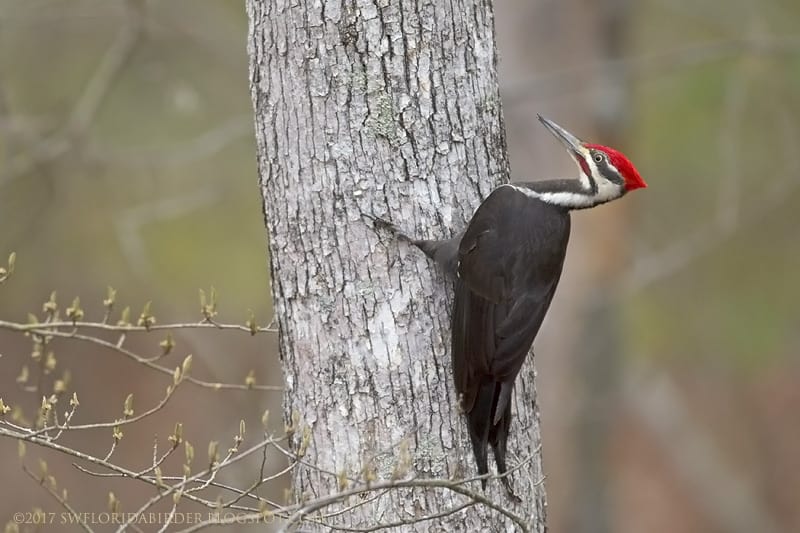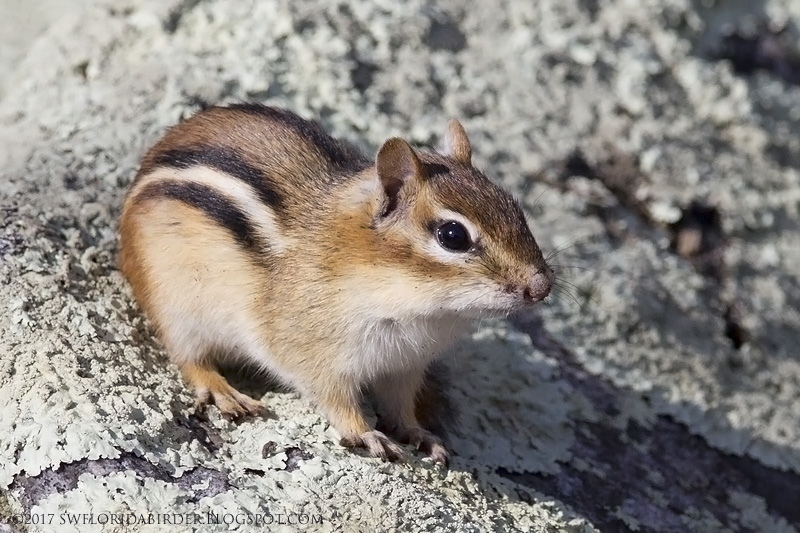It was fairly quickly learned that the feeders used to attract wildlife didn’t entice just the birds. In mid-winter as the squirrels appeared to become more numerous, they became destructive and a disturbance to the winged creatures.
Eastern Bluebirds briefly investigated a pair of bird houses that had been hung for them but the squirrels were even more so interested in what was inside. The chewing on the holes of the homes by the squirrels made the boxes of no interest to the birds.
The squirrels were often observed through a window which on one occasion allowed the photography of a Carolina Wren seen in the Killingworth sanctuary over only a few day’s time.
A few of the birds appeared angry due to being harassed by the squirrels though it is merely their particular nature. The Brown Creeper was observed only in the Winter.
The Pileated Woodpecker above (image 27) was photographed at Casa Almeida in April 2017.
The Northern Cardinal with Blue Jay above (image 1) was photographed at Casa Almeida in February 2017.
The Carolina Wren above (image 2) was photographed at Casa Almeida in February 2017.
The Gray Squirrel above (image 3) was photographed at Casa Almeida in February 2017.
The Common Grackle above (image 4) was photographed at Casa Almeida in April 2017.
The Song Sparrow above (image 5) was photographed at Casa Almeida in April 2017.
The Northern Flicker above (image 6) was photographed at Casa Almeida in April 2017.
The Northern Flicker above (image 7) was photographed at Casa Almeida in April 2017.
The House Finch above (image 8) was photographed at Casa Almeida in April 2017.
The Downy Woodpecker above (image 9) was photographed at Casa Almeida in April 2017.
The Eastern Bluebird above (image 10) was photographed at Casa Almeida in April 2017.
In addition to the squirrels destroying all the plastic feeders despite my best effort to keep the feeders available using parts from one and another with duct tape, they were eating the buds of the rhododendrons thought to be ravaged only by White-tailed deer.
The Chipmunks appear attracted to digging in disturbed ground while doing even more damage to the plants and other vegetation.
The Chipmunk above (image 11) was photographed at Casa Almeida in April 2017.
The Turkey Vulture above (image 12) was photographed at Casa Almeida in April 2017.
The Red-shouldered Hawk with prey above (image 13) was photographed at Casa Almeida in April 2017.
The extremely effective design and effectiveness of traps made for the capturing and relocation of small mammals by the Havahart company cannot be understated. Numbers mentioned in this blog might not be believed.
The copulating Red-bellied Woodpecker above (image 14) was photographed at Casa Almeida in April 2017.
The American Robin above (image 15) was photographed at Casa Almeida in April 2017.
The Northern Cardinal above (image 16) was photographed at Casa Almeida in April 2017.
It has been extraordinary to capture a pair of Chipmunks in the same Havahart trap on two different occasions. Photos will be available to view in the last of this series of blog articles with emphasis on backyard birding.
The Red-shouldered Hawk above (image 17) was photographed at Casa Almeida in April 2017.
The European Starling above (image 18) was photographed at Casa Almeida in April 2017.
The Wild Turkey above (image 19) was photographed at Casa Almeida in April 2017.
Travel was made to the Jersey Shore in April offering an encounter with the White-throated Sparrow which was a life bird for me. All of the other bird species seen in Jersey have been at the feeders in Killingworth.
A Red-shouldered Hawk nest had been re-constructed in the 2017 season with a fledgling off the nest a mere two days ago from this publication making emphasis of success with prey obviously found just a little bit further away.
The Pine Warbler above (image 20) was photographed at Casa Almeida in April 2017.
The Red-shouldered Hawk above (image 21) was photographed at Casa Almeida in April 2017.
The Brown-headed Cowbird above (image 22) was photographed at Casa Almeida in April 2017.
A Gypsy moth outbreak in Connecticut in the 2017 Spring season might be considered a plague after a couple of years of drier conditions favorable for the decades long invasion.
The National Audubon Society has taken the ridiculous position of advocating for the extremely destructive pest which will be mentioned again in the last post of this series.
The Turkey Vulture above (image 23) was photographed at Casa Almeida in April 2017.
The Chipping Sparrow above (image 24) was photographed at Casa Almeida in April 2017.
The White-throated Sparrow above (image 25) was photographed at Casa Kuzminski in April 2017.
Please be sure to be reminded about this Wildlife Blog with the email gadget located at the top of the page.
The Red-shouldered Hawk above (image 26) was photographed at Casa Almeida in April 2017.
Bob Pelkey
This blog is updated every Friday (preferably) and randomly, primarily on the subject of wildlife observation in the state of Florida. This blog is in conjunction with my secondary photo site at http://www.pbase.com/jkrnm5/




























Leave a Reply